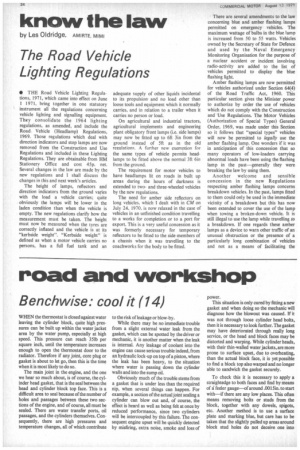know the law
Page 36

Page 37

If you've noticed an error in this article please click here to report it so we can fix it.
by Les Oldridge, AMIRTE, MIMI
The Road Vehicle Lighting Regulations
• THE Road Vehicle Lighting Regulations, 1971, which came into effect on June 1971, bring together in one statutory instrument all the regulations concerning vehicle lighting and signalling equipment. They consolidate the 1964 lighting regulations, as amended, and include the Road, Vehicle (Headlamp) Regulations. 1969. Those regulations which deal with direction indicators and stop lamps are now removed from the Construction and Use Regulations and included in these Lighting Regulations. They are obtainable from HM Stationery Office and cost 45p. net. Several changes in the law are made by the new regulations and I shall discuss the changes in this and next week's articles.
The height of lamps, reflectors and direction indicators from the ground varies with the load a vehicle carries; quite obviously the lamps will be lower in the laden condition than when the vehicle is empty. The new regulations clarify how the measurement must be taken. The height must now he measured when the tyres are correctly inflated and the vehicle is at its "kerbside weight". "Kerbside weight" is defined as when a motor vehicle carries no persons, has a full fuel tank and an adequate supply of other liquids incidental to its propulsion and no load other than loose tools and equipment which it normally carries, and in relation to a trailer when it carries no person or load.
On agricultural and industrial tractors, agricultural implements and engineering plant obligatory front lamps (i.e. side lamps) may now be fitted up to 6ft 3in from the ground instead of 5ft as in the old regulations. A further new exemntion for the same types of vehicle permits headlamps to be fitted above the normal 311 61n from the ground.
The requirement for motor vehicles to have headlamps lit on roads in built up areas during the hours of darkness is extended to twoand three-wheeled vehicles by the new regulations.
The need for amber side reflectors on long vehicles. which I dealt with in CM on July 24, 1970. is now relaxed in the case of vehicles in an unfinished condition travelling to a works for completion or to a port for export. This is a very useful concession as it was formerly necessary for temporary reflectors to be fitted to the side-members of a chassis when it was travelling to the coachworks for the body to be fitted. There are several amendments to the law concerning blue and amber flashing lamps permitted on emergency vehicles. The maximum wattage of bulbs in the blue lamp is increased from 50 to 55 watts. Vehicles owned by the Secretary of State for Defence and used by the Naval Emergency Monitoring Organisation for the purpose of a nuclear accident or incident involving radio-activity are added to the list of vehicles permitted to display the blue flashing light.
Amber flashing lamps are now permitted for vehicles authorized under Section 64(4) of the Road Traffic Act, 1960. This particular section gives the Minister power to authorize by order the use of vehicles which do not comply with the Construction and Use Regulations. The Motor Vehicles (Authorization of Special Types) General Order, 1969, was made under this Section so it follows that "special types" vehicles will now be permitted to legally use the amber flashing lamp. One wonders if it was in anticipation of this concession that so many operators of low-loaders carrying abnormal loads have been using the flashing lamp in the past—generally they were breaking the law by using them.
Another welcome and sensible concession in the new Regulations respecting amber flashing lamps concerns breakdown vehicles. In the past. lamps fitted to them could only be used in the immediate vicinity of a breakdown but this has now been extended to cover the use of the lamp when towing a broken-down vehicle. It is still illegal to use the lamp while travelling to a breakdown. If one regards these amber lamps as a device to warn other traffic of an unusual obstruction or the presence of a particularly long combination of vehicles and not as a means of facilitating the passage of the vehicle through traffic the regulation as it now stands seems reasonable and fair.
The requirements for the positioning of rear lamps and reflectors have been relaxed for certain vehicles. The maximum height from the ground for rear lamps on existing land, agricultural and industrial tractors, fire fighting appliances, local authority vehicles and gritting machines is now 611 3in. A local authority vehicle is defined in the regulations as a vehicle designed and constructed for use and used by a local authority or by any other person solely in connection with the repairing, cleansing or watering of roads, the collection or disposal of refuse, the contents of gullies or cesspools. Only vehicles falling strictly within this definition come within the terms of the exemption. A lorry used by the Parks Department of a local authority for gardening work, for example, would not be able to take advantage of this exemption.
On goods vehicles or trailers specially constructed and designed for moving excavated material being either tippers or fitted with a moving platform for discharging loads then the rear lamps may be up to 411 6in from the ground, instead of the normal 3ft 6in. On trailers which are not more than 4ft wide rear reflectors need only be 14in apart as against the normal 21in. Industrial tractors are now exempt from the requirement to fit stop lamps.
If a rear lamp is marked with the approval mark laid down by the Motor Vehicles (Designation of Approval Marks) Regulations 1968 then the lamps are exempt from the specified minimum size requirements.
Next week I shall look at the provisions in the regulations concerning the use of direction indicators as hazard warnings.




















































































